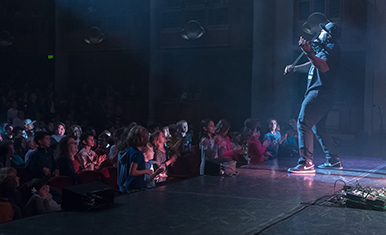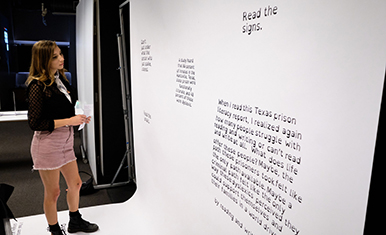From Textbooks to Tech: Augmented Reality Levels Up Language Learning
DU professor Ebrahim Bamanger’s research shows AR helps motivate second-language learners and builds their confidence in the classroom.

How do you keep high school kids engaged in the classroom? One University of Denver professor thinks he has the answer: augmented reality, or AR.
In a new study, Ebrahim Bamanger, teaching assistant professor of Arabic, has found that using an AR-based curriculum can significantly increase student motivation to learn—specifically, to learn English as a second language. Motivation, Bamanger writes, is “an indicator of the success of the educational process” and an important aspect of a holistic educational approach.
AR is a form of technology that combines computer-generated images with the real world in real time, allowing AR users to “view” the digital and physical worlds together. An example of popular AR is the Pokémon Go mobile game, which allows users to “see” animated characters in the world around them through their smartphone cameras. Meta produces AR glasses that allows users to play holographic games and watch videos amid a real-life background.
“Amazon uses it to show customers how products will look in their homes,” Bamanger says. “You’re buying a table, and you can use augmented reality to see how the table will look in your living room.”
Bamanger’s study included first-year high school students in Yemen, all native Arabic speakers with some prior exposure to the English language. Bamanger says that these students had limited opportunities to communicate in English—casually or otherwise—outside of school. The problem with existing English language education in Yemen, he explains, is that most schools use an outdated textbook and cassette tapes that contain recordings of someone speaking English with a British accent—despite the fact that many Yemeni expats move to the United States.
In Bamanger’s experiment, a control group of students were taught using traditional English-language textbooks, while an experimental group were taught with an AR-based curriculum.
The AR curriculum also involved textbooks, but they contained text and images that would trigger AR activities when students pointed their mobile phone cameras at the book. Using their cameras, students could scan any page of the textbook and receive a related AR activity, such as YouTube videos of native English speakers and interactive vocabulary games. What was most important, Bamanger says, is that the AR curriculum was student-led.
“Just giving them links is boring,” he says. “Students learn better when they discover things themselves.”
In partnership with the classroom teachers, Bamanger and his colleagues administered a motivation survey to both groups of students at the beginning of the school semester and again at the end of the semester.
The experimental group exhibited not only higher levels of motivation, but they also reported higher confidence in their language learning and higher levels of attention and satisfaction. The AR-based curriculum fostered a sense of autonomy among the experimental students, Bamanger says.
He also notes that AR could be used as a teaching option during times where remote learning is required.
“Teachers can use AR to adjust their materials as needed and explain the lessons that students can access at any time—and again, as many times as they would like,” he says.
Bamanger says his work shows that AR technology can be used as an effective educational tool—and can provide opportunities to otherwise under-resourced schools in countries where English is not widely spoken or taught.
“In the Yemeni context, where students have limited access to authentic resources and opportunities for real-world language use, AR-based instruction offers an invaluable bridge, connecting learners to globalized, technology-enhanced educational experiences,” he writes.
As Bamanger sees it, AR isn’t just cool tech—it’s a tool with the potential to close learning gaps across the world.




